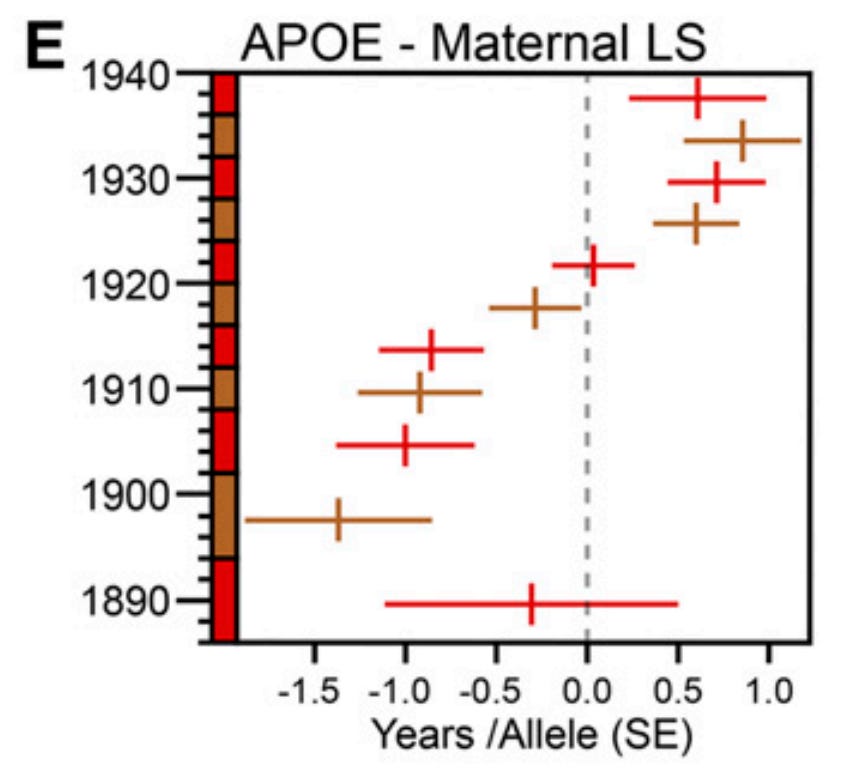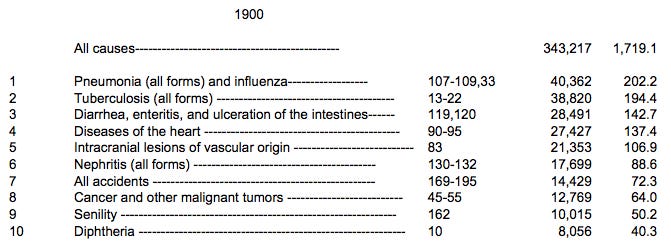A Tale of Two APOE Alleles
Summary: For people born in the US around 1900, the genetic variant APOE ε4 was associated with longer lifespans. More recently, it has become associated with shorter lifespans and a higher risk of Alzheimer's disease (AD). This may be because the environment has changed, and the burden of certain infectious diseases such as diarrhea have decreased substantially. If true, this may help us figure out how APOE ε4 contributes to the risk of AD.
A new study by Wright et al uses data from AncestryDNA to investigate the genetic basis of human lifespan. The majority of the individuals in this study (80%) were from the US.
They found only one gene, APOE, with SNPs that had significant associations with both age and lifespan. The APOE SNP they found that was associated with age was rs429358, which changes the amino acid at position 130 of the APOE protein and distinguishes APOE ε4 from APOE ε3/ε2. The APOE SNP they found to be most associated with lifespan, rs769449, is also highly correlated with APOE ε4.
APOE ε4 is, of course, the genetic variant that mediates the majority of genetic risk for AD.
What is particularly interesting about Wright et al's data is that APOE has a differential effect on longevity based on birth cohort:
As the authors write: "APOE exhibited a negative effect on lifespan in older cohorts and a positive effect in younger cohorts... The minor allele at APOE [read: ε4] was at highest frequency for intermediate lifespan values (74-86 years). This pattern was most pronounced in the younger birth cohorts, and it suggested that this allele [ε4] (or a linked allele or alleles) confers a survival benefit early in life but a survival detriment later in life."
The authors don't speculate much about why APOE ε4 has this differential effect on longevity, but I get to speculate: that's why I have a blog. Here's my explanation, which borrows heavily from previous conversations I've had with the brilliant Dado Marcora.
In 2011, Oriá et al published an intriguing study looking at the effect of APOE ε4 polymorphisms and diarrheal outcomes in Brazilian shanty town children. They found that APOE ε4 was associated with the least diarrhea:
The CDC has this amazing list of the most common causes of death in the US from 1900 to 1998. One of the things that's striking about this data is how much more common diarrhea used to be in the US as a cause of death. In 1900, diarrhea, enteritis, and ulceration of the intestines is the third leading cause of death:
But it starts dropping steadily, and by 1931 it's the 10th leading cause of death:
After that, it no longer appears in the top 10. My guess is that this is probably mostly due to cleaner water. According to the CDC: "In 1908, Jersey City, New Jersey was the first city in the United States to begin routine disinfection of community drinking water. Over the next decade, thousands of cities and towns across the United States followed suit in routinely disinfecting their drinking water, contributing to a dramatic decrease in disease across the country."
Let's assume that what I'm implying is true, that APOE ε4 used to help people in the US live longer by protecting them from diarrheal illnesses that stunt development. If so, it stands to reason that APOE ε3/ε2 might also protect against AD by modulating development.
There is some data to support this. For example, Dean et al 2014 found that "infant ε4 carriers had lower MWF and GMV measurements than noncarriers in precuneus, posterior/middle cingulate, lateral temporal, and medial occipitotemporal regions, areas preferentially affected by AD." It may be wise to consider more heavily the developmental roots of AD.






